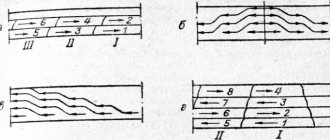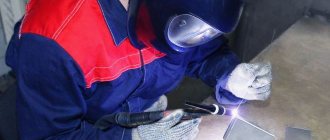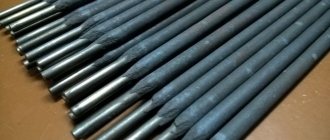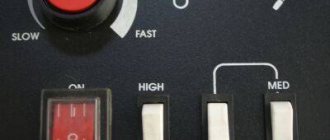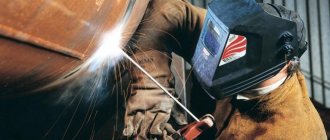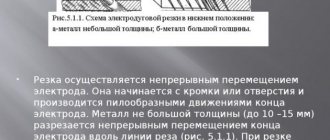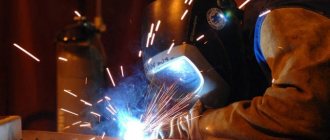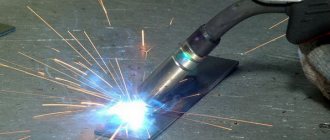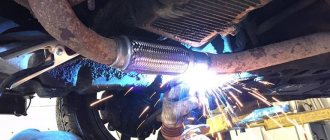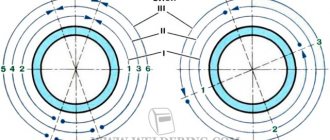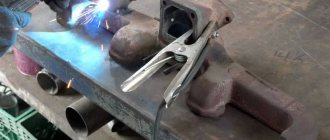Welding tool steel
Tool steel is a type of steel containing less than 1% carbon. This steel is hard and durable, but not wear-resistant, so it is used only in the manufacture of tools. In addition, it has a low purchase price, which makes production profitable.
It is recommended to weld tool steel with a special electrode and using an inverter. Electrodes must be designed specifically to work with this type of steel. We recommend UONI-13/NZh/20X13 rods and a mid-price welding inverter. Be prepared for the fact that welding tool steel will require a lot of effort and patience from you. This is due to the low carbon content.
Semi-automatic welding in a protective environment
If you weld correctly with a semi-automatic machine, you can join galvanized or rusted workpieces. In this case, aluminum or copper filler wire is used to obtain a high-quality, uniform weld.
Before cooking semi-automatic workpieces in a gas environment or using flux, you must:
- clean the joints from dirt, rust, etc., degrease them with a solvent;
- check the operation of gas equipment;
- weld a small section of the joint, if necessary, adjust the equipment settings;
- select the optimal voltage and current.
The easiest way is to cook it correctly with a semi-automatic device in a protective environment of inert gases (argon, helium, nitrogen, carbon dioxide). The gas used does not affect the selected welding technique. Carbon dioxide is most often used because it has good protective properties and a fairly low cost.
Semi-automatic welding of metal workpieces in a shielding gas environment has the following advantages:
- unchanged appearance of the finished structure;
- the ability to process hard-to-reach areas of workpieces;
- thin and durable welded seam;
- minimal amount of waste;
- high speed of work.
The quality of the weld is influenced by the correct distance between the parts being welded, the supply of additive along the joint, and compliance with the work technology.
Welding structural steel
Structural steel is used much more often than tool steel. Everything is made from it: from small parts to factory machines. It is this category that includes welding of 40x steel, 30xgsa steel, 35xgsa steel and other other grades.
What is structural steel? This is a very interesting metal in composition. It consists of various impurities, in particular phosphorus and sulfur. The more of these components there are in the composition, the more unreliable the steel will be, so you need to monitor this indicator. Structural steel can be ordinary, high-quality, high-quality and especially high-quality.
As you understand, the latter type of structural steel contains a minimum of impurities, due to which it is possible to obtain truly high-quality and durable metal. Well, ordinary structural steel contains the most impurities; it is considered the most short-lived. By the way, this classification also has separate subgroups (they differ in the presence of some additional chemical components). But we will not describe the classification in detail so as not to confuse you.
It is precisely because of the possible fragility of structural steel that products are most often made from it that will not be subjected to serious mechanical loads during operation. Now let's move on to the topic of how welding of structural steel products is performed, for example, welding of steel pipes.
First you need to calcinate the workpiece in the oven. This way you will achieve greater ductility of the metal and eliminate its excessive stress. As in the previous case, we recommend using an inverter and coated electrodes. For our purposes, UONI 13/55 brand rods are perfect. They can be easily found in any store, they are inexpensive and with their help it is even possible to weld steel pipelines, not to mention smaller products.
How to cook in a stainless steel pan: 4 useful tips
This post contains affiliate links for which I may earn a commission if you click through and purchase.
Many people are aware of the dangers of Teflon pans and want to switch to something healthier, like stainless steel. But the problem is that they always have the impression that stainless steel cookware is difficult to use, food sticks and therefore difficult to clean.
So, they stick with their nonstick cookware, not knowing that using stainless steel pans properly requires only a little practice. The negative reviews that customers leave after they have problems with recently purchased pots and pans have simply reinforced this the idea that non-stick coating is much easier to use and clean. But take it a step further and you'll see that because of a few sticky complaints, there are many others who don't have any problems with their stainless steel parts.
So why do some people find it really sticky while others use it every day as their favorite utensil?
Tips for Cooking with a Stainless Steel Pan
Are you surprised that you can cook meat without oil in a stainless steel frying pan? Don't believe me? Check it:
This way you can cook without sticking to the pan, even without oil, as shown in the video above. And you can also add a little sauce to clean the pan at the end. How's that for taste and convenience?
Here are some tips to help prevent stickiness while cooking.
Leave food at room temperature
One of the reasons why food may stick to the hob is because it is cold. If you take meat out of the refrigerator and immediately throw it into the pan, you can bet it will stick. Cold will lower the temperature of the oil and hence sticking will occur. Likewise, if there is moisture on the surface of the food, it will also stick because water will also lower the temperature of the oil.
So take your food out of the refrigerator early and let it come to room temperature before you start cooking. Pat it dry and also release all the moisture. This will help minimize stickiness.
Heat the pan and oil
The oil must be hot enough before adding food. Most people would prefer to preheat the pan and once it reaches the desired temperature, oil is added to it. You can also season the pan by heating the oil until smoking. Once the pan has cooled, wipe off any excess oil. This will create a natural non-stick layer that will prevent the surface of the pan from reacting with the food. This video below will show you how it's done:
The slight inconvenience is that you will need to re-season the pan every time you wash it with detergent. Otherwise, just wipe it down and your pan will be ready for your next cooking session.
So why does the oil have to be hot enough before adding food? Well, hot oil is necessary to create a steam effect between the food and the pan. This layer will prevent food from reacting to the pan and sticking. Steam occurs due to the moisture in the food that is released when the desired temperature is reached.
When to add products
The next question then becomes: when to add food? How do you know if the oil is hot enough? This requires a little trial and error.
There is no hard and fast rule for how long it takes for the oil to get hot enough to add food due to the different pans used. Cheap cookware like the Cook N Home Stainless Steel will definitely have a slimmer design than, say, a Calphalon Contemporary. Due to the different designs of cookware, you will need to see what works for you. Your stove settings may also be different from others because medium heat for you may be medium-low for someone else. So, you also need to play with the heat settings to get things right.
But as a general rule, the best time to add food is when the oil is quickly spreading through the pan and starting to ripple. Keep in mind that you can't wait too long because once the oil starts smoking, the temperature will become too high to cook and will cause burning.
Some people also wonder when to add oil to a stainless steel pan? To do this, you can do a water test. If the water sizzles and evaporates quickly, then you can add oil. Some will go a step further and wait for the Leidenfrost effect. This is when a drop of water moves along the tray instead of quickly evaporating. However, this may be too hot for some. However, the general rule is to follow, although it may take a few tries to get it perfect.
Don't turn food too early
Food will stick to the cooking surface if you try to turn it over before it is ready. During the frying process, moisture from the food is released and evaporated for some time. The food will not burn if there is still moisture in it and you hear a hissing sound. When the sizzling starts to subside, try turning the food over.
Of course, you will need to monitor the process closely. Your food will burn quickly once the sizzling stops because when there is no more water in it, the temperature of the oil will rise.
What is the best stainless steel cookware to buy?
If you have the money, three-ply cookware is a good investment. Calphalon Tri-Ply and Cuisinart Multicald Pro are two quality cookware you might want to consider. Although they are expensive, at least they will last you a long time, unlike non-stick cookware, and they are the best option when you need to fry and sear. On the other hand, you also don't need a really expensive kit like the All Clad D5 series to cook delicious meals. In most cases, the extra features will only give you minimal or even no added benefit to your cooking process to justify the much higher cost.
Other cookware you may like:
.
Alloy steel welding
Alloy steels are one of the most popular. Their main feature is their composition. Various alloying components are added to it, thanks to which the steel can be given the desired properties and characteristics. Simply put, due to alloying additives, it becomes possible to adjust the composition to your needs.
If necessary, such steel can be made stronger, more durable and better. You can literally change its physical and chemical properties by simply adding alloying elements to the composition.
A few more advantages of alloy steel: increased heat resistance, corrosion resistance (not at the level of stainless steel, of course, but still high resistance). To weld this type of steel, you can use arc welding and electrodes that contain fluorine and calcium. But we recommend gas welding. It is more complicated, but at the same time allows you to get better connection quality.
Gas welding technology, of course, differs from classic semi-automatic or inverter welding. Here the heat is generated not by the electric arc, but by the welding flame. It is formed when a flammable gas mixes with oxygen and burns. The technology of welding carbon steels using gas requires skill and experience. But that doesn't mean you can't experiment. Practice on a scrap piece of metal before doing the main work.
Welding high-strength and hardened steels
Composition and properties of high-strength steels
Steels with a tensile strength greater than 1500 MPa are called high-strength. This limit is achieved by selecting the chemical composition and the most suitable heat treatment. This level of strength can be formed in medium-carbon alloy steels (40ХН2МА, 30ХГСН2А) by using hardening with low tempering (at 200...250оС). Alloying such steels with W, Mo, V complicates softening processes, which reduces the threshold of cold brittleness and increases resistance to brittle fracture. How to weld metal if you have high-strength steel in front of you? Welding of high-strength steels is characterized by the use of some additional technological techniques (welding in cascades, slides, sections, preheating, the use of a soft layer, and others).
Hardened steels (structure)
Isothermal hardening of medium-carbon alloy steels gives them slightly lower strength, but greater toughness and ductility. Therefore, they are more reliable in operation than low-tempered and hardened ones. Low-tempered and hardened medium-carbon steels with a high level of strength have an increased susceptibility to stress concentrators and a tendency to brittle fracture. Because of this, they are recommended to be used for work involving smooth loading.
High-strength steels include so-called spring steels. They contain 0.5...0.75% C and are additionally alloyed with other elements. Heat treatment of alloy spring steels (quenching 850...880°C, tempering 380...550°C) ensures high strength and fluidity. Isothermal hardening can be used. Welding of spring steel is carried out with mandatory preliminary heat treatment, with heating during welding and further heat treatment.
Maraging steels (04Х11Н9М2Д2ТУ, 03Н18К9М5Т) also belong to high-strength steels. They are superior to medium-carbon alloy steels in structural strength and manufacturability. Such steels are characterized by high resistance to brittle fracture, a low threshold of cold brittleness and low sensitivity to cuts with a strength of about 2000 MPa. Maraging steels are carbon-free alloys of iron and nickel and are additionally alloyed with molybdenum, cobalt, aluminum, chromium, titanium and other elements. These steels have high structural strength in the temperature range from cryogenic to 500°C and are used in the manufacture of artillery and small arms barrels, rocket engine housings, gears, spindles, and so on.
Weldability of high-strength alloys
For the manufacture of heavily loaded engineering products, high-pressure vessels and other critical structures, medium-carbon high-strength steels are used, which, after appropriate heat treatment, have a strength of 1000...2000 MPa with a sufficiently high level of ductility. The required level of strength while maintaining high ductility is achieved by complex alloying of steel with various elements, the main ones of which are nickel, chromium, molybdenum and others. These elements strengthen ferrite and increase the hardenability of steel. Heating the product during welding does not reduce the cooling rate of the metal to values less than critical, and promotes grain growth, which leads to the occurrence of cold cracks and causes a decrease in deformability.
Therefore, such metals are welded without preheating, but using special welding techniques (blocks, cascade, short or medium-length sections). Special devices are also used that heat the completed seam and thereby increase the time it remains in a certain temperature range. To increase the time the heat-affected zone metal remains at a temperature above the point of formation of the martensitic structure, a so-called annealing bead is applied, the boundaries of which are within the weld metal.
In order to avoid cracks when cooling the welded joint, it is necessary to use welding materials that would ensure the production of weld metal with high deformability. This is achieved when the weld metal and weld metal are less alloyed than the steel being welded. In this case, the seam will be like a soft layer with temporary resistance, but with increased deformation capacity. To ensure the technological strength of welds made with low-alloy welding materials, carbon in the weld must be contained in an amount of no more than 0.15%.
When welding hardened steel, it is recommended to apply a coolant to the welded joint area after passing the welding arc. This is done to reduce the degree of softening of the heat-affected zone. Shower water, compressed air or a steam-air mixture can serve as a coolant, depending on the composition of the material being welded. This cooling reduces the time the metal remains in the high temperature zone.
Welding technology for joining high-strength steels
When welding medium-alloy, deeply hardening, high-strength steels, it is necessary to select welding materials that will ensure the production of welds with high deformation capacity with a minimum amount of hydrogen in the weld pool. This is achieved by using low-alloy welding electrodes, which do not contain organic substances in the coating and are subjected to high-temperature calcination (low-hydrogen electrodes). In this case, it is necessary to exclude other sources of saturation of the weld pool with hydrogen during welding (rust, moisture, etc.). High technological strength is obtained with the following content of alloying elements in the weld metal: C – no more than 0.15%; Si – no more than 0.5%; Ni – no more than 2.5%; Mn – no more than 1.5%; Cr – no more than 1.5%; V – no more than 0.5%; Mo – no more than 1.0%.
Increasing the weld properties to the required level is possible by alloying the weld metal at the expense of the base metal. The required strength characteristics of the weld metal are achieved by alloying it with elements that increase strength, but do not reduce its impact strength and deformability. To weld medium-carbon high-strength steels, you need to choose welding materials that contain less alloying elements than the base metal.
Manual arc welding with coated electrodes
For welding medium-alloyed high-strength steels, electrodes of types E-13Х25Н18, E-08Х21Н10Г6 and others are used in accordance with GOST 10052-75 and GOST 9467-75. If the steel before welding was subjected to heat treatment for high strength (quenching and tempering or normalization), and after welding - tempering to relieve stress and equalize the mechanical properties of the welded joint, then the criterion for determining the preheating temperature will be the cooling rate at which partial hardening would occur near-heat zone. This ensures that there are no cracks during the welding process and before further heat treatment.
To improve the weldability of hardened metals, special electrodes are required
In the case when heat treatment of a welded product cannot be done, for example, due to its large dimensions, a non-hardening layer of metal is deposited onto the edges of the part to be welded with austenitic or low-carbon electrodes. The thickness of this layer should be such that the temperature of the steel under the layer during the welding process does not exceed the tempering temperature during heat treatment of parts with deposited edges. Such parts are welded with austenitic or low-carbon and low-hydrogen electrodes without heating and further heat treatment. The welding mode is taken according to the recommendations for austenitic electrodes.
Welding work in shielding gases
High quality of welded joints made of medium-carbon high-strength steels with a thickness of 3...5 mm is achieved by argon arc welding with a non-consumable electrode. The filler material for gas shielded arc welding should be selected depending on the gas in which the welding takes place. The first layer is performed without an additive with full penetration of the joint edges, the second - with transverse low-frequency vibrations of the electrode and mechanical feed of the filler wire. It is also possible to perform the third layer with transverse vibrations of the electrode without filler wire at a low mode to ensure a gradual transition from the weld to the base metal.
To increase the penetration ability of the arc during argon-arc welding, activating fluxes are used, which make it possible to eliminate the cutting of edges with thicknesses of 8...10 mm. Flux is also used, which is a mixture of components (TiO2, SiO2, NaF, Cr2O3). This method with activating flux is effective with mechanized methods to obtain a uniform penetration depth. The non-consumable electrode for this welding method is selected from the most resistant grades of tungsten.
Modern argon burner
When welding medium-alloyed high-strength steels in shielding gases (mainly inert or their mixtures with active ones), low-carbon alloyed and austenitic high-alloy wires are used, for example, Sv-08Kh20N9G7TT, Sv-03KhGN3MD, Sv-10KhGSN2MT, Sv-10Kh16N25-AM6, Sv-08Kh21N10G6 . However, it is not possible to obtain equal strength of the weld metal and the steel being welded. In this case, it is possible to ensure equal strength due to the effect of contact strengthening of the soft weld metal. This effect can be realized using the so-called slot groove, which is butt joints with a narrow gap.
Submerged arc welding
Structural elements of edge preparation for automatic and semi-automatic submerged arc welding are performed in accordance with GOST 8713-79. However, in the range of thicknesses for which welding without groove and with beveled edges is possible, the latter should be preferred. When mechanized submerged arc welding, edge preparation, technique and welding modes are required in which the proportion of base metal in the weld would be minimal. But this technique increases the likelihood of hot cracks forming in the welds.
The choice of flux depends on the brand of electrode wire. When using low-carbon wire, welding is performed under acidic high- and medium-manganese fluxes. When using low-alloy wires, the best results are achieved by using low-silicon and low-manganese fluxes. Welding of medium-alloyed high-strength steels with austenitic wire of the Sv-08Kh21N10G6 or Sv-08Kh20N9G7T grades is carried out only using non-oxidizing or weakly oxidizing basic fluxes.
Electroslag welding
Scheme of the welding process
This type of welding work can be rationally used for joining thick-sheet structures made of medium-alloy high-strength steels. The main types and structural elements of welded joints and seams must comply with the requirements of GOST 15164-78. When welding with a consumable tip and wire electrodes, electrode wires are selected from among the groups of alloyed or high-alloy wires in accordance with GOST 2246-70. To prevent cracks in the heat-affected zone when welding rigidly fixed elements, it is necessary to use preheating to 150...200°C.
The low cooling rate of the heat-affected zone during electroslag welding leads to a long stay in the zone of high temperatures, causing grain growth and embrittlement of the metal. In this regard, after electroslag welding of medium-alloy high-strength steels, it is necessary to perform high-temperature heat treatment of welded products to restore mechanical properties to the required level. The time from the end of welding to the heat treatment must be regulated.
Welding low alloy steel
Low-alloy (they are also often low-carbon) steels are metals containing an extremely small amount of alloying elements (usually no more than 2-3%). They consist largely of iron, a small amount of carbon and various impurities.
Low-alloy steels usually include silicon, nickel, tungsten, aluminum, copper and many other metals. By the way, on our website we devoted several articles to aluminum welding and the specifics of the work. We also talked about copper welding. Read these articles to get up to speed.
Tips for proper semi-automatic welding without gas
It is not necessary to cook correctly with a semi-automatic device in a protective gas environment. You can control the quality of work and minimize the formation of oxides in another way - through the use of flux-cored (cored) filler wire. Under the influence of high temperature, the powder covering the additive burns, forming a gaseous environment and ensuring a high-quality weld.
Welding with semi-automatic equipment without the use of inert gas is performed in several stages:
- choosing a suitable flux additive;
- setting wire feed parameters;
- placing flux inside the funnel;
- opening the protective valve that allows flux to enter the welding zone;
- launching the device;
- activation of the electric arc;
- direct connection of workpieces.
Parts made from different metals, including aluminum blanks with non-standard properties, can be properly welded using a semi-automatic machine. Aluminum and its alloys are welded in a protective argon atmosphere, which prevents the formation of an oxide film on the surface of the parts.
Correct semi-automatic welding of corner joints
Corner joints can be formed using various semi-automatic welding modes. The blanks themselves can be positioned differently relative to each other:
- With a perpendicular position, only an internal seam is possible. When working with pipes, a concentric connection is formed around the circumference.
- When the angle between the workpieces is up to 60°, the highest quality seams are obtained, since the parts are processed from all sides.
Sheet metals and pipes are connected with a butt weld, which can be one-sided, one-sided with processing, or two-sided. When working with metals up to 4 mm thick, one-sided welding is used; for thicker workpieces, only two-sided welding is suitable.
Single-sided welding requires careful preliminary preparation of the part. A high-quality seam cannot be achieved without thorough processing of the edges with a file or grinder. When cutting, the tool is positioned at an angle of about 45° to the edge of the workpiece.
The lap joint is suitable for designs that require high tear resistance of the seam. Seams are laid on both sides of the surfaces being joined to prevent moisture from accumulating in the welding area. A T-joint is used to weld the base of a metal structure.
